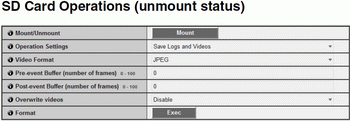[Memory Card] SD Memory Card Operations (Unmounted Status)

(1) [Mount/Unmount] - In unmount status, [Mount] will appear. Click [Mount] to mount the SD memory card.
Note
SD, SDHC and SDXC memory cards can be used with the camera. When an SD memory card is inserted in the card slot, it is mounted automatically. It is also mounted automatically if inserted in the camera at the time of booting. For inserting and removing the SD memory card, see “Installation Guide” > “Using an SD Memory Card”.
(2) [Operation Settings] - Set write operations to the SD memory card to [Save Log] or [Save Logs and Videos].
Note
• The following settings and operations will record video on an SD memory card.
- When a network error occurs during recording-mode stream
- When [Video Record Action] in the [Event] menu is set to [Record to SD Card], and an event (volume detection, external device input or timer) setting is enabled and [Enable] is selected for [Video Record] - When manually recorded to SD memory card from the Admin Viewer
• New files cannot be saved to the SD memory card if there is no free space.
(3) [Video Format] - Select the [JPEG] or [H.264] video format to make recordings to an SD memory card. If [H.264] is selected, select [Use bit rate control] under [Bit Rate Control] in [Video]. Video is recorded in this format when [Record to SD Card] is selected in [Video Record Action] (p. 62) of the [Event] menu.
Note
• When [JPEG] is selected in [Video Format], video is always recorded at a 1 fps frame rate
• When a network error occurs during recording-mode stream, video is saved in the JPEG format regardless of the [Video Format] setting (the frame rate is fixed at 1 fps).
• Video size and quality of the recorded video are made according to the settings in the [Video] menu.
(4) [Pre-event Buffer (number of frames)] / [Pre-event Buffer (sec)] - Enter the number of frames or seconds of video to be buffered before the event. The maximum amount is number of frames for a [JPEG] selection and number of seconds for an [H.264] selection in [Video Format].
(5) [Post-event Buffer (number of frames)] / [Post-event Buffer (sec)] - Enter the number of frames or seconds of video to be buffered after the event. The maximum amount is number of frames for a [JPEG] selection and number of seconds for an [H.264] selection in [Video Format].
(6) [Overwrite videos] - Select [Enable] or [Disable] for the overwrite setting of video that is recorded to an SD memory card when an event occurs. If you select [Enable], videos recorded using an event and timer will be overwritten. Overwriting is performed when the number of recordings that can be stored (100,000 files) for each of events and timers is exceeded. Overwriting is not performed when there is insufficient space on the SD memory card
Important
• When an H.264 video is saved to an SD memory card, the following restrictions apply to [H.264] of [Video].
- Only [Use bit rate control] can be selected for [Bit Rate Control].
- Only [3072] or less can be selected for [Target Bit Rate (kbps)].
- Only one of [0.5], [1], and [1.5] can be selected for [I Frame Interval (sec)].
• Since the [Pre-event Buffer] and [Post-event Buffer] set the maximum value, it may not be possible to record the specified number of frames or seconds of video depending on conditions
(7) [Format] - Click [Exec] to format the SD memory card.